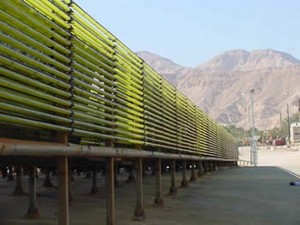No, you can’t simply pump the green scum that forms on your swimming pool into your gas tank, but motorists in the San Francisco area now can fill up on a new biofuel derived from algae.
There are plenty of proponents searching for ways to replace petroleum with renewable fuels, though some alternatives, such as corn-based ethanol, have come under fire, especially in the wake of last summer’s nationwide drought. But the biofuel system developed by South San Francisco-based Solazyme, Inc. won’t tap the food supply.
“We are putting a stake in the ground,” said Matt Horton, chief executive officer of Propel Fuels, which is supplying the fuel to four stations near San Francisco and which would like to expand distribution to “hundreds of stations like this in California.”
The algae-based fuel is known as B20, which means a mix of 80% conventional diesel and 20% biofuel. That’s generally the maximum motorists can find at a public filling station – though company officials insist they could use 100% organic diesel in a conventional vehicle without and change in performance or reduction in the life of a diesel engine.
The biggest problem would be price, as the biofuel currently costs more to produce than the stuff refined from petroleum. The first four stations were charging $4.25 a gallon, about the same as standard diesel fuel in the San Francisco area.
The debut is part of a month-long pilot program though it is clear Solazyme and Propel would like to continue marketing the biofuel if customers agree.
Scientists around the world have been looking for ways to replace petroleum with alternatives that could prove, cleaner, renewable and, if possible, cheaper. The most commonly available biofuel is ethanol, an alcohol that can be used in many late-model automobiles in a mix of 85% ethanol and 15% gasoline. It is also used as an additive in conventional gasoline in much of the country, albeit at much lower concentrations.
There has been significant debate about ethanol but one of the biggest concerns is that most production facilities rely on corn to make the fuel. In fact, the Environmental Protection Agency may waive current mandates due to the shortage of corn in the wake of last summer’s drought.
Proponents have been hoping to shift away from food stock-based ethanol to so-called cellulosic ethanol that can be produced from a variety of alternative stocks, from grain chaff to waste paper. The ramp-up of cellulosic ethanol has been slow, however. And, in general, consumers have failed to rush to ethanol pumps, whatever the source, despite subsidized lower prices.
The sponsors are hoping that most motorists won’t care where the B20 comes from – except those who would prefer to find a diesel supply that is at least partly based on renewables.
A number of companies are investing into algae-based diesel production, including Solray Energy and Aquaflow Bionomic Corp., of New Zealand. They are experimenting with several alternative production methods. One would feed wastewater from sources like sewage plants into open ponds. The other approach used a more condensed method of piping that it believes can store more of the primitive lifeform in a given footprint of land.
Like competitors, they and California’s Solazyme then refine the raw material this “algae crude” into usable fuel that can be mixed with conventional diesel.

